Chart Color Schemes
est. as @ -- *
ABS ERP | -- people | --
2021 Census | -- people
Sales Activity
Curious about local property values? Filter the chart to assess the volume and appreciation (including resales) trends and regional comparisons, or scroll to the map below view this information at an individual property level.
Find a Recent Sale
Sales Detail
Population
Burpengary - East lies within the top 10% of areas nationally in terms of population growth performance according to AreaSearch analysis of short and medium-term trends
Based on AreaSearch's analysis, Burpengary - East's population was around 8,969 as of Aug 2025. This reflected an increase of 2,311 people (34.7%) since the 2021 Census, which reported a population of 6,658 people. The change was inferred from the estimated resident population of 8,721 from the ABS as of June 2024 and an additional 604 validated new addresses since the Census date. This level of population equated to a density ratio of 329 persons per square kilometer, providing significant space per person and potential room for further development. Burpengary - East's growth of 34.7% since the 2021 census exceeded both the national average (8.6%) and the state average. Population growth was primarily driven by interstate migration, contributing approximately 86.6% of overall population gains during recent periods.
AreaSearch adopted ABS/Geoscience Australia projections for each SA2 area, released in 2024 with 2022 as the base year. For areas not covered and years post-2032, Queensland State Government's SA2 area projections were used, released in 2023 based on 2021 data. These state projections did not provide age category splits; hence proportional growth weightings were applied in line with ABS Greater Capital Region projections for each age cohort, released in 2023 based on 2022 data. Looking ahead, Burpengary - East is predicted to experience exceptional growth, placing it in the top 10 percent of statistical areas analysed by AreaSearch. The area is expected to grow by 8,650 persons to 2041 based on the latest population numbers, recording a gain of 93.7% in total over the 17 years.
Frequently Asked Questions - Population
Development
The level of residential development activity in Burpengary - East was found to be higher than 90% of real estate markets across the country
Burpengary - East has averaged approximately 192 new dwelling approvals annually over the past five financial years, totalling 961 homes. As of FY-26, seven approvals have been recorded. On average, 3.5 new residents arrive per year for each dwelling constructed between FY-21 and FY-25. This has led to a significant demand exceeding supply, typically resulting in price growth and increased buyer competition.
The average construction cost value of new properties is $430,000, aligning with regional patterns. In FY-26, $6.1 million in commercial approvals have been registered, indicating the area's residential character. Compared to Greater Brisbane, Burpengary - East has 130.0% more development activity per person, offering buyers greater choice, although construction activity has recently eased. This high level of developer confidence is substantially higher than the national average. New developments consist of 93.0% detached dwellings and 7.0% townhouses or apartments, preserving the area's low-density nature and attracting space-seeking buyers with an average of 60 people per approval.
By 2041, Burpengary - East is projected to grow by 8,402 residents. Current development appears well-matched to future needs, supporting steady market conditions without extreme price pressure.
Frequently Asked Questions - Development
Infrastructure
Burpengary - East has moderate levels of nearby infrastructure activity, ranking in the top 50% nationally
Changes to local infrastructure significantly influence an area's performance. AreaSearch has identified 20 projects likely impacting the area. Key projects include Burpengary East Wastewater Treatment Plant Upgrade, Avaline, Freshwater by Ingenia Lifestyle, and North Harbour. The following list details those most relevant.
Professional plan users can use the search below to filter and access additional projects.
INFRASTRUCTURE SEARCH
 Denotes AI-based impression for illustrative purposes only, not to be taken as definitive under any circumstances. Please follow links and conduct other investigations from the project's source for actual imagery. Developers and project owners wishing us to use original imagery please Contact Us and we will do so.
Denotes AI-based impression for illustrative purposes only, not to be taken as definitive under any circumstances. Please follow links and conduct other investigations from the project's source for actual imagery. Developers and project owners wishing us to use original imagery please Contact Us and we will do so.
Frequently Asked Questions - Infrastructure
North Harbour Business Park
76-hectare master-planned industrial and business precinct in Burpengary East, forming part of the broader North Harbour community. Offers industrial lots from 1,800 sqm to over 4 ha suitable for manufacturing, marine industry, logistics, warehousing and commercial offices. Multiple stages released, with Stage 1 sold out and fully settled, Stages 2-4 progressively under construction or civil works in 2025. When complete the business park is expected to support thousands of jobs and form a key employment hub between Brisbane and the Sunshine Coast.
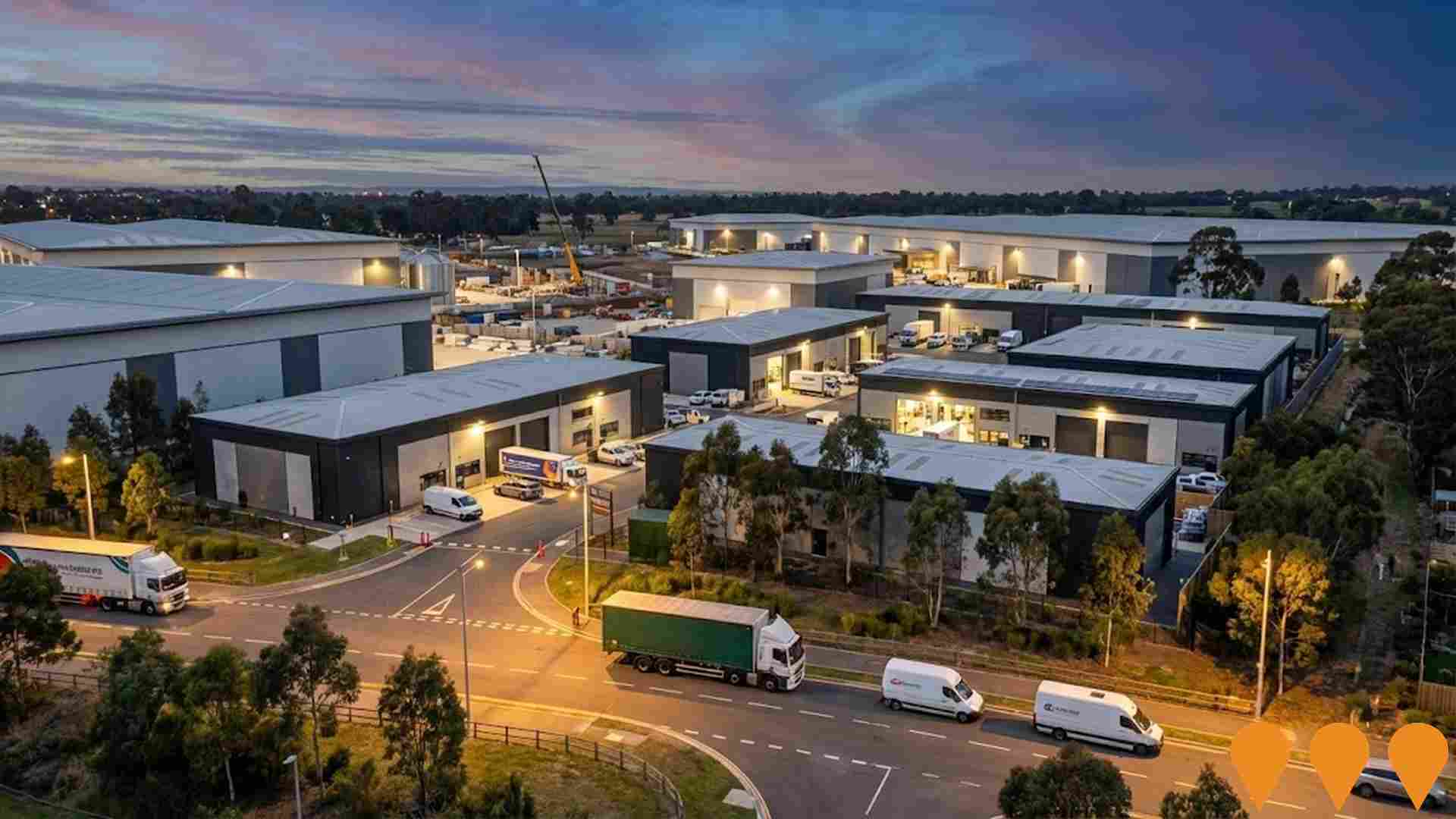
North Harbour Priority Development Area
The North Harbour Priority Development Area (PDA) in Burpengary East, declared 30 July 2025, is a $2.74 billion master-planned waterfront community spanning over 1,000 hectares. It incorporates the existing North Harbour residential estate, a new 400-berth marina, marine industry precinct, retail and tourism hubs, hotels, and 319 hectares of public riverfront parkland along 12 km of the Caboolture River. The PDA will deliver approximately 3,700 additional dwellings (on top of existing homes), creating a total community of over 10,000 residents when complete.
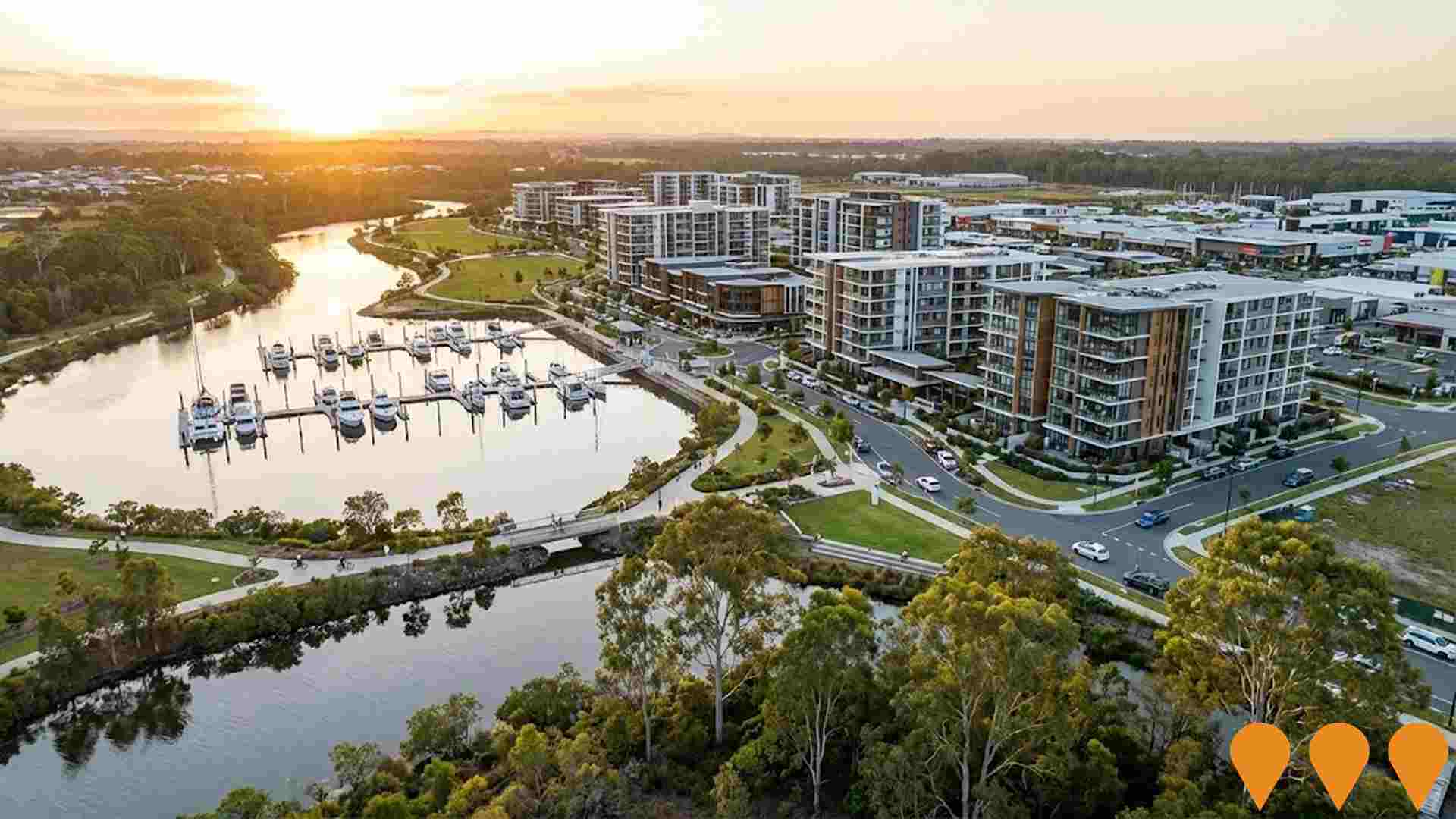
North Harbour
North Harbour is a $2.74 billion masterplanned waterfront community in Burpengary East, delivering up to 3,700 homes across approximately 1,000 acres (~400ha PDA + existing). The development includes a residential precinct (currently under construction), mixed-industry business park, 400-berth marina with 500 dry boat stackers and private pontoons, maritime industry and tourism precincts, retail village, hotel sites, and over 300 hectares of parkland and open space with 12km of public riverfront along the Caboolture River. Declared a Priority Development Area (PDA) on 30 July 2025.
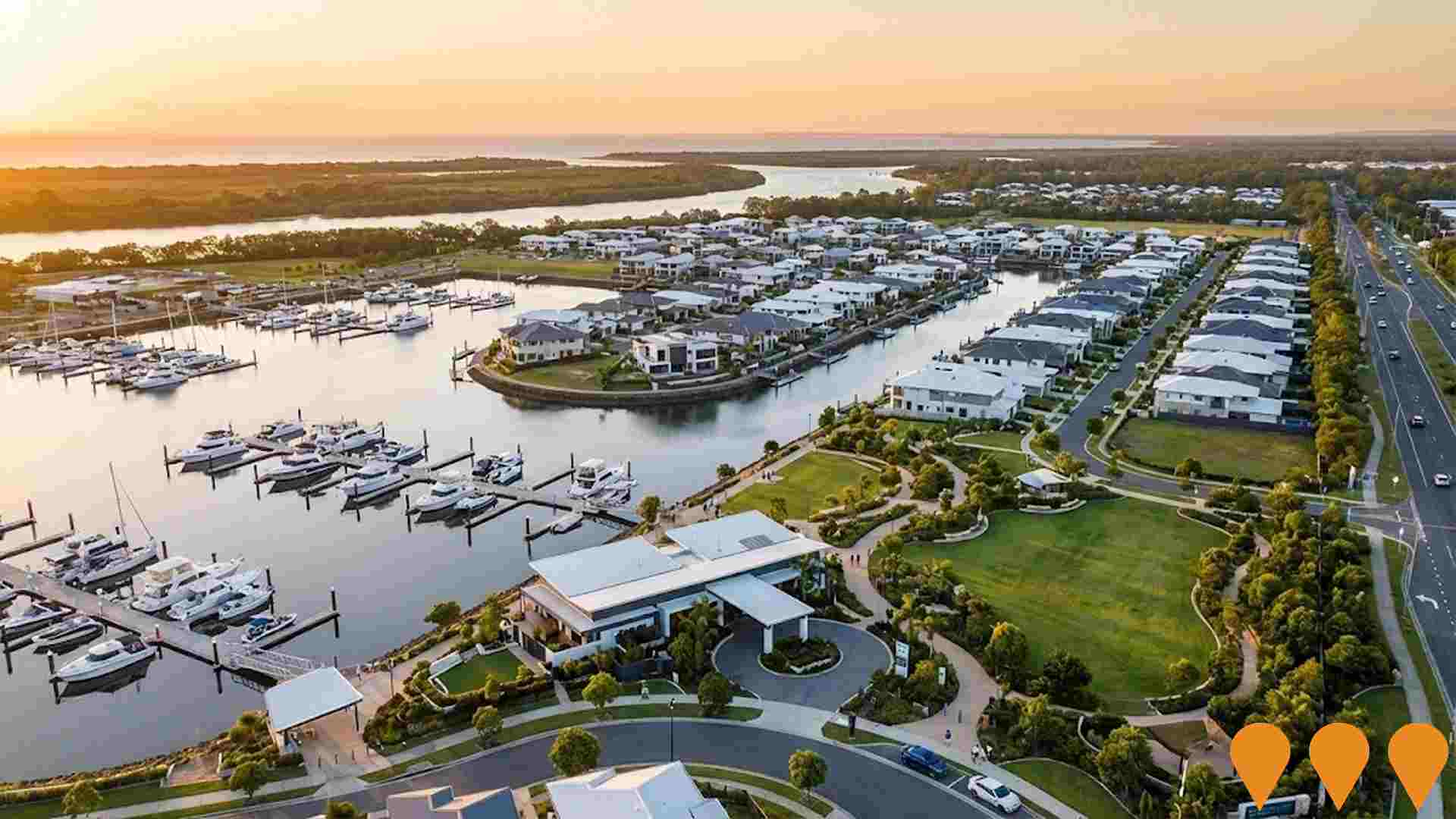
Bruce Highway Upgrade - Anzac Avenue to Caboolture-Bribie Island Road
A major upgrade of the Bruce Highway to widen the corridor from 4 to 6 lanes and separate local and through traffic. The $733 million Anzac Avenue to Uhlmann Road section is committed for detailed design (commencing 2026) and construction. The project includes upgrading interchanges at Uhlmann Road, Buchanan Road, and Caboolture-Bribie Island Road, and constructing collector-distributor roads to improve safety and reduce congestion.
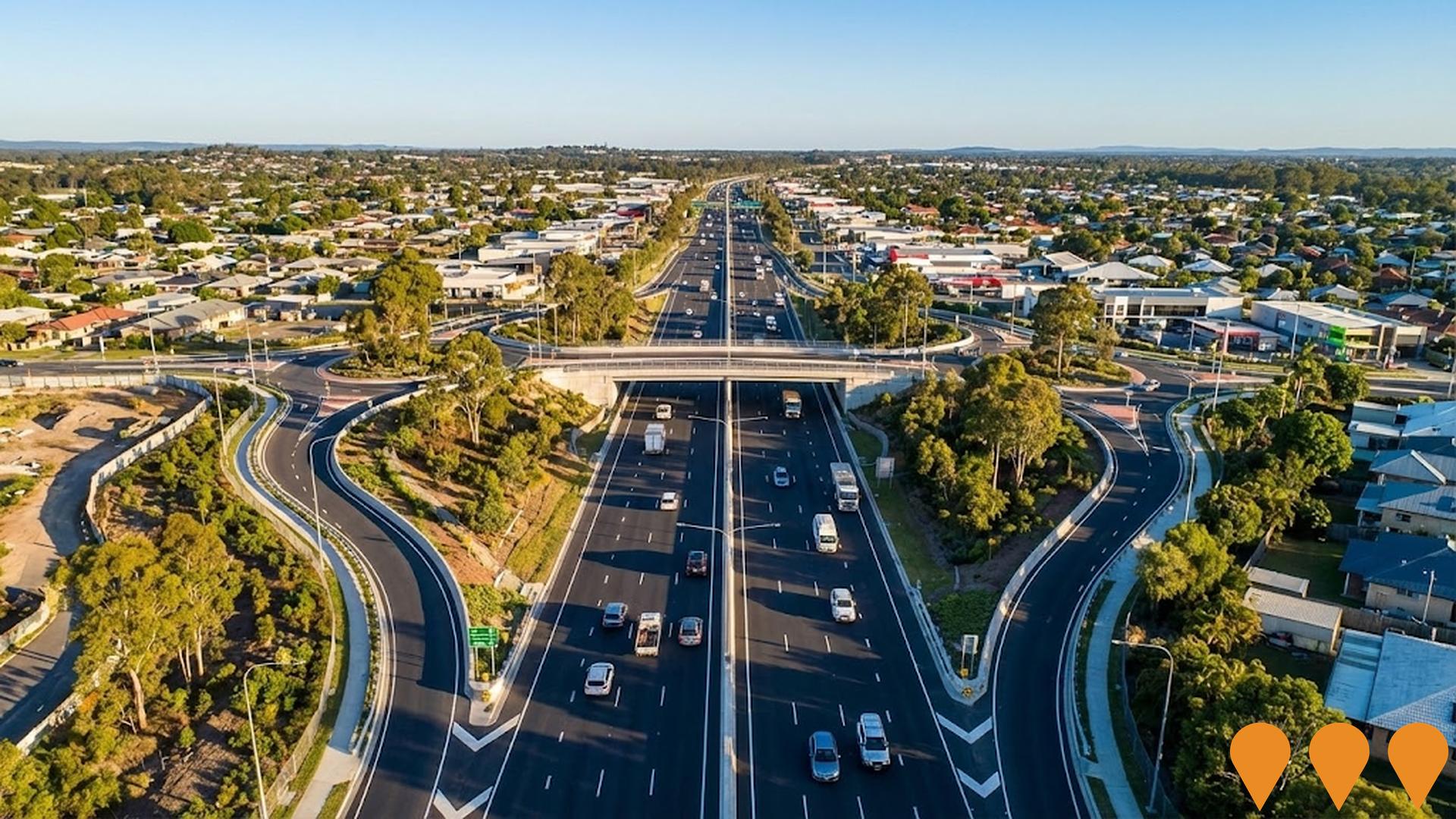
Pine Valley Water Supply Project
Major water infrastructure project delivered by Unitywater in partnership with Downer. Includes a new 15ML reservoir at Jacko Place, Morayfield and over 8km of large-diameter water mains to support rapid population growth in Caboolture West, Morayfield and Narangba. Designed to provide reliable water supply for more than 100,000 new residents over the next 20 years. Construction commenced early 2025 with practical completion expected mid-2027.
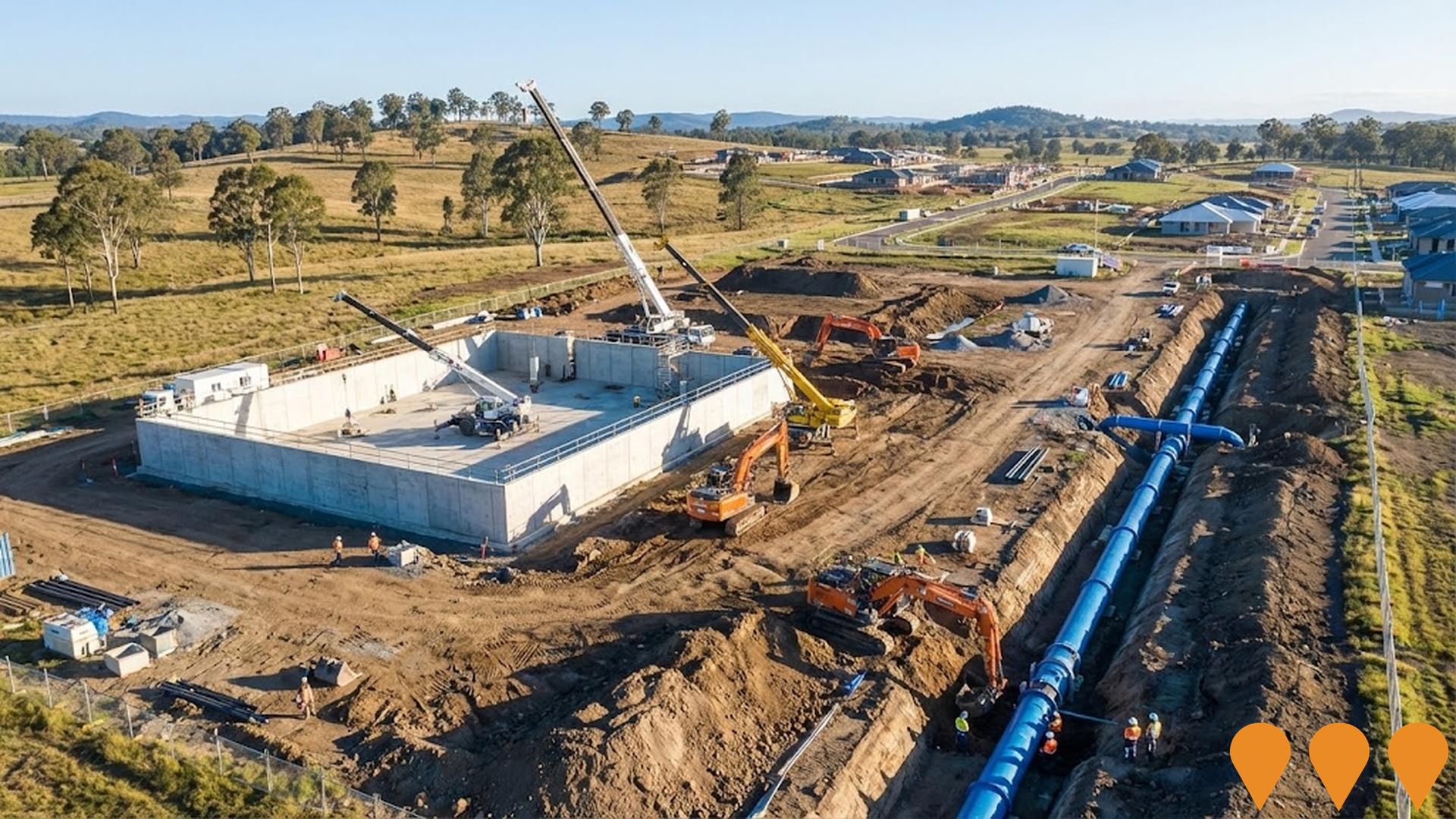
Burpengary East Shopping Centre
A $25 million neighbourhood shopping centre developed by Lancini Property Group, anchored by a full-line Woolworths supermarket with Direct-to-Boot service, plus 12 specialty stores, alfresco dining, community plaza, children's play area and 235+ car parks. Construction is well underway with practical completion expected late 2025.

Burpengary East Wastewater Treatment Plant Upgrade
The upgrade to the Burpengary East Wastewater Treatment Plant increases capacity by 30% from 10 million to 14 million litres per day to support regional growth. It includes new inlet works with enhanced odour control, a new bioreactor, a new clarifier, upgraded effluent disinfection, electrical and control upgrades, and an internal plant road upgrade.
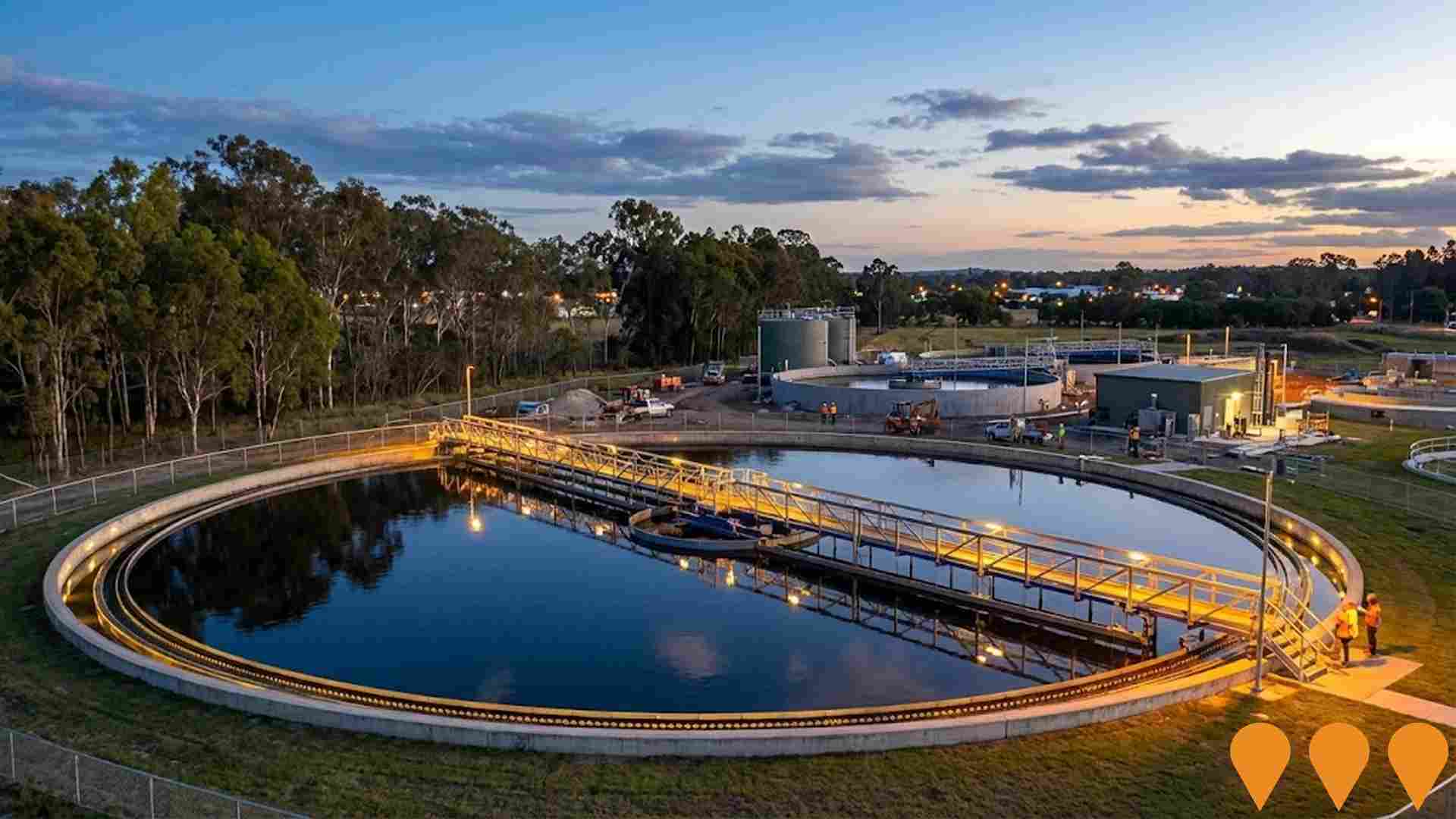
Avaline
A boutique bayside community with 188 residential blocks, 1.2ha community park, over 2.6ha open space, approvals for childcare and medical centre, focused on active healthy living. Final homes nearing completion, all stages registered and sold out.
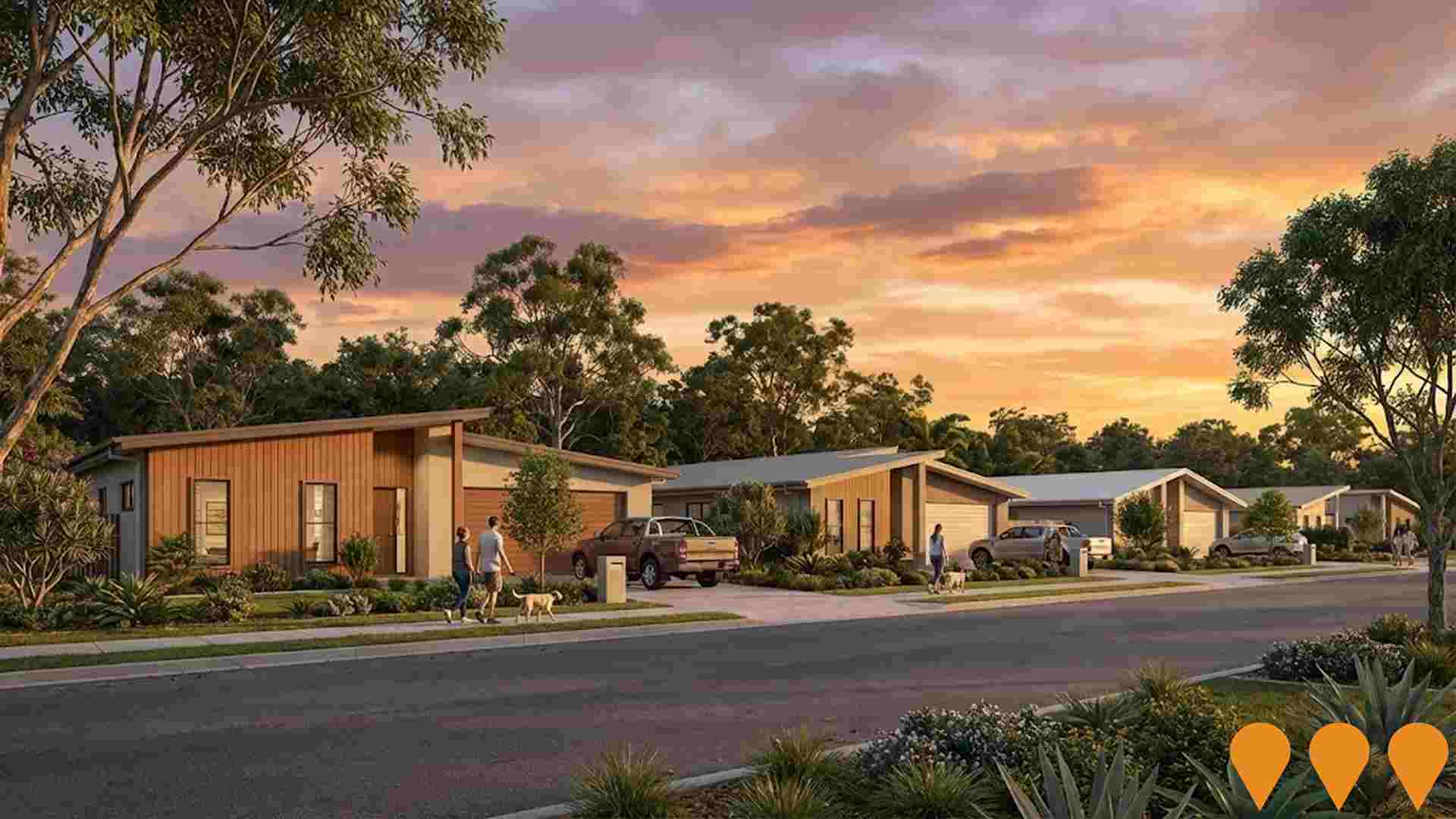
Employment
AreaSearch analysis of employment trends sees Burpengary - East performing better than 90% of local markets assessed across Australia
Burpengary - East has a balanced workforce with both white and blue collar jobs. The construction sector is prominent here, with an unemployment rate of 2.0% as of June 2025.
This rate is lower than Greater Brisbane's rate of 4.1%. The estimated employment growth in the area over the past year was 9.3%. As of June 2025, 4,826 residents are employed, with a workforce participation rate of 69.9%, higher than Greater Brisbane's 64.5%. The dominant employment sectors among residents include health care & social assistance, construction, and retail trade.
Construction is particularly specialized here, employing 1.6 times the regional level. However, professional & technical services employ only 4.7% of local workers, below Greater Brisbane's 8.9%. Employment opportunities locally may be limited, as suggested by the count of Census working population versus resident population. Between June 2024 and June 2025, employment increased by 9.3%, while labour force grew by 8.3%, reducing the unemployment rate by 0.9 percentage points. In contrast, Greater Brisbane saw employment rise by 4.4% and unemployment fall by 0.4 percentage points over the same period. According to Jobs and Skills Australia's national employment forecasts from May 2025, national employment is projected to expand by 6.6% over five years and 13.7% over ten years. Applying these projections to Burpengary - East's employment mix suggests local growth of approximately 6.3% over five years and 13.2% over ten years.
Frequently Asked Questions - Employment
Income
The area exhibits notably strong income performance, ranking higher than 70% of areas assessed nationally through AreaSearch analysis
Burpengary - East has a median taxpayer income of $53,173 and an average income of $61,288 according to postcode level ATO data aggregated by AreaSearch for the financial year 2022. This is lower than the national average, with Greater Brisbane's median income being $55,645 and average income $70,520. By September 2025, estimates suggest the median income will be approximately $60,612 and the average $69,862, based on Wage Price Index growth of 13.99% since financial year 2022. The 2021 Census ranks household incomes at the 86th percentile with a weekly income of $2,346. In terms of income distribution, 40.1% of residents (3,596 people) fall into the $1,500 - $2,999 bracket, similar to the metropolitan region where this cohort represents 33.3%. Economic strength is evident with 32.6% of households earning high weekly incomes exceeding $3,000, supporting increased consumer spending. High housing costs consume 15.2% of income, but strong earnings place disposable income at the 85th percentile. The area's SEIFA income ranking places it in the 6th decile.
Frequently Asked Questions - Income
Housing
Burpengary - East is characterized by a predominantly suburban housing profile, with above-average rates of outright home ownership
Dwelling structure in Burpengary - East, as per the latest Census, consisted of 94.2% houses and 5.8% other dwellings (semi-detached, apartments, 'other' dwellings). This compares to Brisbane metro's 83.4% houses and 16.5% other dwellings. Home ownership in Burpengary - East was 24.1%, with the rest being mortgaged (58.1%) or rented (17.7%). The median monthly mortgage repayment was $2,100, higher than Brisbane metro's average of $1,625. Median weekly rent in Burpengary - East was $430, compared to Brisbane metro's $335. Nationally, Burpengary - East's median monthly mortgage repayments were significantly higher at $2,100 versus the Australian average of $1,863, and rents were substantially above the national figure of $375.
Frequently Asked Questions - Housing
Household Composition
Burpengary - East features high concentrations of family households, with a higher-than-average median household size
Family households account for 88.1% of all households, including 46.0% couples with children, 31.4% couples without children, and 9.5% single parent families. Non-family households constitute the remaining 11.9%, with lone person households at 9.6% and group households comprising 2.3%. The median household size is 3.1 people, larger than the Greater Brisbane average of 2.7.
Frequently Asked Questions - Households
Local Schools & Education
Educational attainment in Burpengary - East aligns closely with national averages, showing typical qualification patterns and performance metrics
The area's university qualification rate is 15.7%, significantly lower than Greater Brisbane's average of 30.5%. Bachelor degrees are the most common at 11.6%, followed by postgraduate qualifications (2.1%) and graduate diplomas (2.0%). Vocational credentials are prevalent, with 45.2% of residents aged 15+ holding them, including advanced diplomas (11.8%) and certificates (33.4%). Educational participation is high at 29.7%, comprising primary education (10.7%), secondary education (8.9%), and tertiary education (4.2%).
Schools appear to be located outside the immediate catchment boundaries, requiring families to access them in neighboring areas.
Frequently Asked Questions - Education
Schools Detail
Nearby Services & Amenities
Transport
No public transport data available for this catchment area.
Frequently Asked Questions - Transport
Transport Stops Detail
Health
Burpengary - East's residents are relatively healthy in comparison to broader Australia with the level of common health conditions among the general population somewhat typical, though higher than the nation's average among older cohorts
Burpengary East's health metrics are close to national benchmarks. Common health conditions among its general population are somewhat typical but higher than the national average among older cohorts.
Approximately 51% of the total population (~4,538 people) have private health cover, which is relatively low compared to Greater Brisbane's 47.6%. The most common medical conditions in the area are mental health issues and asthma, affecting 8.8% and 8.0% of residents respectively. 68.7% of residents declare themselves completely clear of medical ailments, compared to 61.9% across Greater Brisbane. As of 2016, 11.6% of residents are aged 65 and over (1,038 people), lower than Greater Brisbane's 17.0%. Health outcomes among seniors require more attention than the broader population.
Frequently Asked Questions - Health
Cultural Diversity
Burpengary - East ranks below the Australian average when compared to other local markets across a number of language and cultural background related metrics
Burpengary-East was found to have a below average level of cultural diversity, with 81.0% of its population born in Australia, 89.3% being citizens, and 93.4% speaking English only at home. Christianity is the predominant religion in Burpengary-East, comprising 50.0% of the population, compared to 44.7% across Greater Brisbane. The top three ancestry groups in Burpengary-East are English (32.7%), Australian (29.3%), and Scottish (7.0%).
Notably, New Zealanders make up 1.3% of Burpengary-East's population compared to the regional average of 1.1%, while Maori and Samoan populations are also slightly higher at 1.3% and 0.6% respectively.
Frequently Asked Questions - Diversity
Age
Burpengary - East hosts a young demographic, positioning it in the bottom quartile nationwide
The median age of Burpengary-East is 34 years, which is slightly lower than Greater Brisbane's figure of 36 years and substantially under Australia's national average of 38 years. Compared to Greater Brisbane, Burpengary-East has a higher proportion of residents aged 5-14 (13.9%) but fewer residents aged 65-74 (6.2%). Between the 2021 Census and the present day, the age group 35-44 has increased from 13.2% to 15.3%, while the 15-24 cohort has risen from 13.4% to 14.7%. Conversely, the 45-54 age group has declined from 14.0% to 12.8%, and the 0-4 age group has decreased from 7.4% to 6.2%. Population forecasts for Burpengary-East indicate significant demographic changes by 2041, with the 45-54 cohort projected to grow strongly at a rate of 123%, adding 1,405 residents to reach a total of 2,550.



